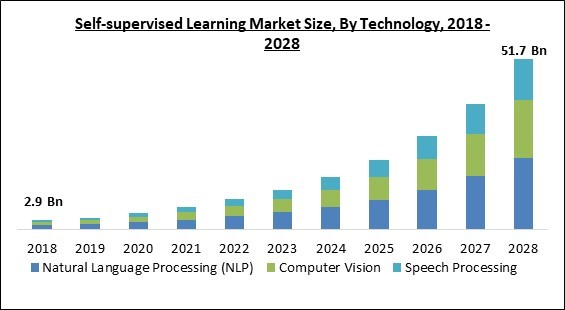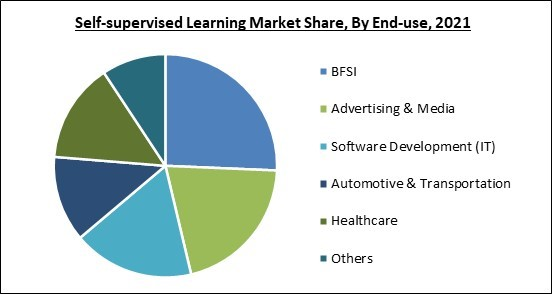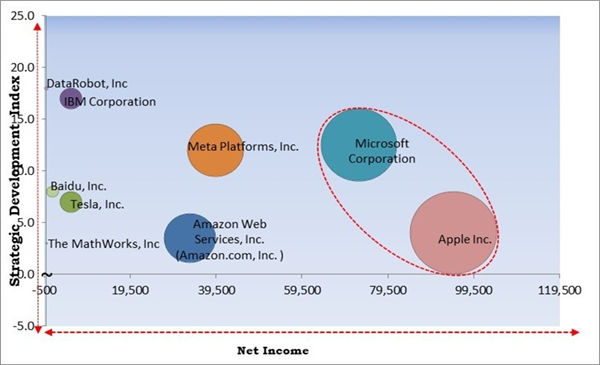The Global Self-Supervised Learning Market size is expected to reach $51.7 billion by 2028, rising at a market growth of 33.3% CAGR during the forecast period.
Self-supervised learning is in a stage of development that calls for a skilled workforce. The demand for self-supervised learning applications among industries is being driven by factors like the expanding applications of technologies like voice recognition and face detection and the growing need to streamline workflow across industries. Additionally, the market is likely to expand due to the growing digitalization of society.
Companies like Apple and Microsoft, both based in the United States, are investing more money in R&D projects. Additionally, these businesses are investigating cutting-edge technologies like AI and ML. Self-supervised learning is being studied and experimented with by market participants like the American company Meta, creating significant growth possibilities for the industry.
The development of AI systems that can learn from vast amounts of meticulously labeled data has advanced significantly in recent years. This supervised learning paradigm has a track record of producing expert models that excel at the task for which they were developed. Building more intelligent generalist models that can perform multiple tasks and learn new skills without vast amounts of labeled data is hampered by supervised learning.
The major strategies followed by the market participants are Product Launches. Based on the Analysis presented in the Cardinal matrix; Apple, Inc. and Microsoft Corporation are the forerunners in the Self-supervised Learning Market. Companies such as Meta Platforms, Inc., Amazon Web Services, Inc. (Amazon.com, Inc.) and IBM Corporation are some of the key innovators in Self-supervised Learning Market.
The market research report covers the analysis of key stake holders of the market. Key companies profiled in the report include Baidu, Inc., Apple, Inc., Tesla, Inc., IBM Corporation, Microsoft Corporation, Amazon Web Services, Inc. (Amazon.com, Inc.), Meta Platforms, Inc., SAS Institute, Inc., The MathWorks, Inc., and DataRobot, Inc.
Self-supervised learning is in a stage of development that calls for a skilled workforce. The demand for self-supervised learning applications among industries is being driven by factors like the expanding applications of technologies like voice recognition and face detection and the growing need to streamline workflow across industries. Additionally, the market is likely to expand due to the growing digitalization of society.
Companies like Apple and Microsoft, both based in the United States, are investing more money in R&D projects. Additionally, these businesses are investigating cutting-edge technologies like AI and ML. Self-supervised learning is being studied and experimented with by market participants like the American company Meta, creating significant growth possibilities for the industry.
The development of AI systems that can learn from vast amounts of meticulously labeled data has advanced significantly in recent years. This supervised learning paradigm has a track record of producing expert models that excel at the task for which they were developed. Building more intelligent generalist models that can perform multiple tasks and learn new skills without vast amounts of labeled data is hampered by supervised learning.
COVID-19 Impact Analysis
In response to the COVID-19 pandemic, most IT professionals said they had accelerated the roll-out of AI (artificial intelligence). Additionally, chatbots were created using machine learning (ML) during the pandemic to screen COVID-19 symptoms and respond to public inquiries. In order to combat the COVID-19 pandemic, machine learning and artificial intelligence technologies are being used in research fields. Healthcare & agriculture are currently two of the most crucial sectors in these unprecedented times. Since ML allows computers to work the same as human intelligence & ingest massive amounts of data in order to find patterns and insights, it has received a lot of media attention. This has further supported the growth of the self-supervised learning market during the pandemic period.Market Growth Factors
Growing Application Of Ml In The Healthcare Sector
ML technology is already helping in a number of healthcare-related situations. This technology is used in the healthcare industry to evaluate millions of different data points, forecast outcomes, provide quick risk scores, and allocate resources precisely, among many other things. Disease Recognition and Diagnosis Finding and diagnosing illnesses & conditions that can occasionally be challenging to identify are one of the most significant applications of this technology in healthcare.Increasing Usage Of The Cloud Computing Technology Across The World
The market is expanding as a result of the rising use of cloud computing technology and usage of social media platforms. All businesses now largely use cloud computing, which offers enterprise storage solutions. With the adoption of cloud storage, data analysis is carried out online, giving the benefit of analyzing the real-time data generated on the cloud. Data analysis is possible at any time and from any location due to cloud computing.Market Restraining Factors
Lack Of Accuracy & Technical Restrictions
A wide range of advantages provided by the ML platform contributes to the market's expansion. However, the platform is missing some essential elements that are anticipated to impede market expansion. The market is significantly hampered by the presence of inaccurate algorithms, which are occasionally underdeveloped. Precision is crucial for manufacturing companies using big data and machine learning. The algorithm's slightest error could lead to the creation of inaccurate items.End-Use Outlook
Based on end-use, the self-supervised learning market is segmented into healthcare, BFSI, automotive & transportation, software development (IT), advertising & media and others. In 2021, the BFSI segment dominated the self-supervised learning market by generating maximum revenue share. The BFSI sector is expanding across the globe and the digitalization in the sector is also rising. The way that individuals frequently communicate as well as conduct business has changed as a result of the COVID-19 pandemic.Technology Outlook
On the basis of technology, the self-supervised learning market is fragmented into natural language processing (NLP), computer vision, and speech processing. The computer vision segment covered a significant revenue share in the self-supervised learning market in 2021. The fundamental concept behind self-supervised learning in computer vision is to build a model that can handle any basic computer vision task using the input data or image data, and while the model is resolving the issue, it can learn from the structure of the objects shown in the image.Regional Outlook
Region wise, the self-supervised learning market is analyzed across North America, Europe, Asia Pacific and LAMEA. In 2021, the North America region led the self-supervised learning market with the largest revenue share. The United States-based businesses place a high priority on digital transformation, and they are frequently recognized as early adopters of cutting-edge technologies such as big data analytics, Internet of Things (IoT), additive manufacturing, AI, augmented reality (AR), connected industries, machine learning (ML), and virtual reality (VR), and the newest telecommunications technologies such as 4G, 5G, and LTE.Cardinal Matrix-Self-supervised Learning Market Competition Analysis
The major strategies followed by the market participants are Product Launches. Based on the Analysis presented in the Cardinal matrix; Apple, Inc. and Microsoft Corporation are the forerunners in the Self-supervised Learning Market. Companies such as Meta Platforms, Inc., Amazon Web Services, Inc. (Amazon.com, Inc.) and IBM Corporation are some of the key innovators in Self-supervised Learning Market.
The market research report covers the analysis of key stake holders of the market. Key companies profiled in the report include Baidu, Inc., Apple, Inc., Tesla, Inc., IBM Corporation, Microsoft Corporation, Amazon Web Services, Inc. (Amazon.com, Inc.), Meta Platforms, Inc., SAS Institute, Inc., The MathWorks, Inc., and DataRobot, Inc.
Strategies deployed in Self-supervised Learning Market
Partnerships, Collaborations and Agreements:
- May-2021: Microsoft came into a partnership with Darktrace, a leading autonomous cyber security AI company. Under this partnership, Microsoft & Darktrace would provide improved security across multi-platform & multi-cloud environments, automate threat investigations and allow teams to prioritize strategic tasks that matter.
- Jan-2021: Baidu entered into a partnership with BlackBerry, a former brand of smartphones, tablets, and services. This partnership aimed at helping car manufacturers quickly produce safe autonomous vehicles & promote the development collaboratively of the intelligent networked automobile industry.
Product Launches and Product Expansions:
- Aug-2022: Meta AI launched PEER, a collaborative language model trained to mimic the writing process. PEER has been developed to enhance the model’s ability to write texts in different domains. With PEER, one can perform edits in many domains, which makes it better at following instructions and enhances its ability to cite and quote from relevant documents.
- Jul-2022: Meta AI released an open-sourced model in order to make Wikipedia entries more appropriate. This launch would help in scaling the work of volunteers by efficiently recommending citations & accurate sources. It would highlight questionable citations, enabling human editors to assess the cases that are most likely to be flawed without having to sift through thousands of properly cited statements.
- Jun-2022: DataRobot expanded its DataRobot AIX 2022 by making it available on Google Cloud. The expansion would enable consumers to accelerate and scale their business with AI. Also, consumers would be able to leverage the Google Cloud marketplace to streamline their procurement & deployment processes and generate intelligent business solutions on Google Cloud.
- Jun-2022: Meta unveiled Visual-Acoustic Matching, Visually-Informed Dereverberation, and VisualVoice, three new artificial intelligence (AI) models. This product focused on making the sound more realistic in mixed & virtual reality experiences.
- May-2022: Microsoft Azure released i-Code, a general framework that allows flexible multimodal representation learning. This product would allow the flexible integration of speech, vision, and language modalities & learn their vector representations in a unified manner.
- Jan-2022: Meta launched data2vec, the first high-performance self-supervised algorithm that learns in the same way for speech, vision, and text. By the introduction of data2vec, Meta aimed at building machines that learn about different aspects of the world around them without having to rely on labeled data.
- Sep-2021: DataRobot introduced DataRobot 7.2. This product would have features like Composable ML & code-centric data pipelines for data science experts, Continuous AI and bias monitoring for ML operators, and Decision Intelligence Flows & Pathfinder solution accelerators for the front-line decision-makers.
- Sep-2021: Tesla launched Tesla D1, a new chip designed specifically for artificial intelligence. Tesla D1 adds a total of 354 training nodes that form a network of functional units, that are interconnected to create a massive chip. Each functional unit comes with a quad-core, 64-bit ISA CPU which uses a specialized, custom design for compilations, transpositions, broadcasts, and link traversal.
- Aug-2021: Baidu introduced Kunlun 2, its second-generation AI chip. This launch focused on diversifying its business beyond advertising to AI and driverless cars.
- Aug-2021: IBM introduced IBM Telum Processor. The launch focused on bringing deep learning inference to enterprise workloads to help address fraud in real time. Telum would enable IBM to leverage deep learning inferencing on high-value transactions, designed to greatly enhance the ability to intercept fraud, among other use cases.
- Oct-2020: Microsoft introduced a machine learning cyber-attack threat matrix. This launch would empower security analysts in their battle to protect AI-powered technology.
- May-2020: MathWorks launched Release 2020a. This product would serve with new capabilities specifically for automotive & wireless engineers in addition to hundreds of new & updated features for all users of MATLAB and Simulink. By this launch, the engineers would train neural networks in the updated Deep Network Designer app, manage multiple deep learning experiments in a new Experiment Manager app, and choose from more network options to generate deep learning code.
Mergers & Acquisitions:
- Jul-2022: IBM completed the acquisition of Databand, an Israel-based data observability software provider. The acquisition would IBM offers the most comprehensive set of observability capabilities for IT across application, data, and machine learning.
- May-2022: Microsoft took over Nuance Communications, a leader in conversational AI and ambient intelligence across industries. This acquisition would bring together Nuance's best-in-class conversational AI and ambient intelligence with Microsoft's secure and trusted industry cloud offerings.
- Dec-2021: IBM closed on the acquisition of Instana, a leading enterprise observability and application performance monitoring platform. With the acquisition of Instana, IBM would offer industry-leading, AI-powered automation capabilities to manage the complexity of modern applications that span hybrid cloud landscapes.
- Jul-2021: DataRobot signed an agreement to acquire Algorithmia, a machine learning operations platform. The acquisition would stabilize DataRobot’s position as the preeminent provider of comprehensive solutions in the MLOps space, focused on bringing machine learning models into production.
- May-2021: DataRobot entered an agreement to acquire Zepl, a cloud data science, and analytics platform. The acquisition would unlock new capabilities within DataRobot’s enterprise AI platform for the world’s most advanced data scientists. Also, the acquisition of Zepl would help in providing advanced data scientists more flexibility to use the company's enterprise AI platform within their present workflows, including the ability to use their code.
- Jul-2020: IBM announced the acquisition of WDG Automation, the Brazilian software provider of robotic process automation. The acquisition aimed to advance IBM's comprehensive AI-infused automation capabilities, spanning business processes to IT operations. This acquisition would enhance IBM's comprehensive AI-infused automation capabilities, spanning business processes to IT operations
- May-2020: Apple took over Inductiv, a Canada-based machine learning startup. This acquisition aimed at enhancing data used in Siri.
- Apr-2020: Tesla acquired DeepScale, an American technology company. This acquisition aimed at accelerating Tesla's machine learning development. Under this acquisition, Tesla would design its computer chip to power its self-driving software with DeepScale's specialization in computing power-efficient deep learning systems.
Geographical Expansions:
- Feb-2022: Microsoft expanded its geographical footprint in India. This expansion aimed at providing support for consumers building & operating applications and workloads. Microsoft Cloud would manage end-to-end business needs across public, private & hybrid scenarios while helping businesses leverage digital capabilities and technologies like ML, AI, IoT, and analytics.
- Jan-2021: AWS expanded its geographical footprints by providing AWS CCI Solutions to its partners all over the world. AWS CCI solution would allow leveraging AWS's ML capabilities with the current contact center provider to gain greater efficiencies & deliver increasingly tailored consumer experiences.
Scope of the Study
Market Segments Covered in the Report:
By End-use
- BFSI
- Advertising & Media
- Software Development (IT)
- Automotive & Transportation
- Healthcare
- Others
By Technology
- Natural Language Processing (NLP)
- Computer Vision
- Speech Processing
By Geography
- North America
- US
- Canada
- Mexico
- Rest of North America
- Europe
- Germany
- UK
- France
- Russia
- Spain
- Italy
- Rest of Europe
- Asia Pacific
- China
- Japan
- India
- South Korea
- Singapore
- Malaysia
- Rest of Asia Pacific
- LAMEA
- Brazil
- Argentina
- UAE
- Saudi Arabia
- South Africa
- Nigeria
- Rest of LAMEA
Key Market Players
List of Companies Profiled in the Report:
- Baidu, Inc.
- Apple, Inc.
- Tesla, Inc.
- IBM Corporation
- Microsoft Corporation
- Amazon Web Services, Inc. (Amazon.com, Inc.)
- Meta Platforms, Inc.
- SAS Institute, Inc.
- The MathWorks, Inc.
- DataRobot, Inc.
Unique Offerings from the Publisher
- Exhaustive coverage
- The highest number of Market tables and figures
- Subscription-based model available
- Guaranteed best price
- Assured post sales research support with 10% customization free
Table of Contents
Chapter 1. Market Scope & Methodology
Chapter 2. Market Overview
Chapter 3. Competition Analysis - Global
Chapter 4. Global Self-supervised Learning Market by End-use
Chapter 5. Global Self-supervised Learning Market by Technology
Chapter 6. Global Self-supervised Learning Market by Region
Chapter 7. Company Profiles
Companies Mentioned
- Baidu, Inc.
- Apple, Inc.
- Tesla, Inc.
- IBM Corporation
- Microsoft Corporation
- Amazon Web Services, Inc. (Amazon.com, Inc.)
- Meta Platforms, Inc.
- SAS Institute, Inc.
- The MathWorks, Inc.
- DataRobot, Inc.
Methodology

LOADING...











